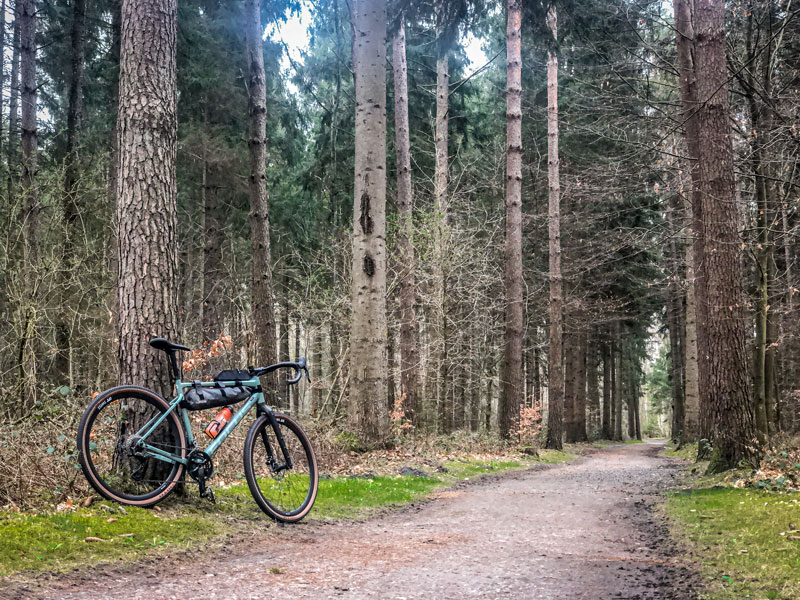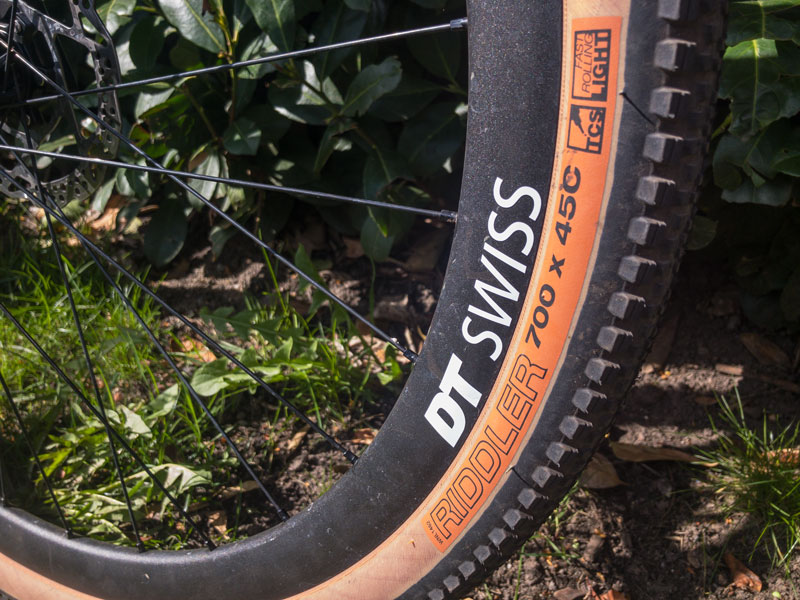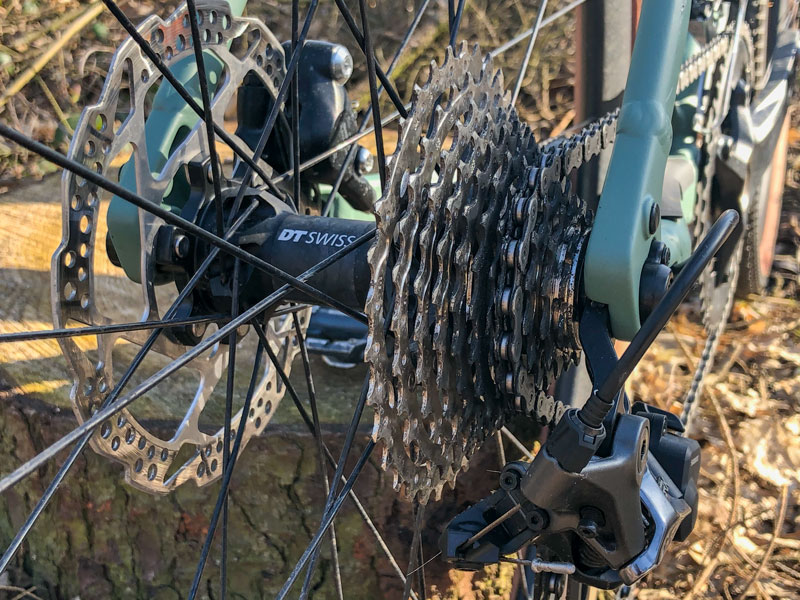To be honest, I didn’t really consider Focus to have gravel or bikepacking bikes on my radar, but rather mountain bikes and other bikes. But then the Stuttgart-based company, which develops its bikes under Derby Cycle Holding and has them built in Cloppenburg, presented its first gravel bike, the Focus Atlas.

Atlas – a pretty powerful name for a bike. Atlas is a titan from Greek mythology who was forced to support the firmament of the (then western) world. But Atlas is also the name of the former king of Mauritania, whose name stands for the cartographic atlas we know today. (Now you’ve learned something again!)
And that’s exactly what it’s all about: being able to explore the world on your doorstep or in faraway places – carried by the Focus Atlas Adventure Gravelbike and ready to discover new paths.
I could now write that the Focus Atlas rides both sportily and comfortably and is touring-friendly. That you can set new records with it in the forest and off asphalt and that it gravels even faster and more agile. But what are you supposed to do with it?
There are already enough bikes for everything and with many bikes you can ride everything well. So it’s quite pleasant when a manufacturer stands up and says:
We have built a bicycle that is not made for “…winning races, setting world records or outperforming others. It’s made for losing – your mind, your sense of time, yourself. It’s made for getting out in nature, having adventures, meeting people and just having a great time.”
So it’s about slowing down, taking time to explore, enjoying the ride – and the bike is just the tool for these kinds of experiences. A wonderful contrast in a time that is rediscovering cycling for itself, but also often interprets it in a purely competitive and performance-oriented way. And the Focus Atlas is the bike to this contrast.
Introducing The Focus Atlas 6.8 gravel bike in detail
In the centre, of course, is the aluminium frame in what I consider a pleasantly light green. The frame is very tidy, the cables are routed inside as often as possible. It is well made and weighs 2,000g.
The Atlas is designed in Germany, the frames are welded in Asia and painted in Lithuania, and the bike is also assembled there.

You might notice the welds. On this Focus states:
“The welds are what is known as double welding. This makes the transition between the pipes smoother, but it is also much more expensive than a conventional weld. Double Welding not only looks better, but also gives the frame more stability.”

I like that the frame has enough eyelets to attach three bottle cages. Five eyelets on the down tube alone (3 top, 2 bottom), two on the seat tube and there are also two eyelets on the top tube to attach bolt-on cockpit/top tube bags accordingly. The frame can also accommodate mudguards and luggage racks.

In addition, there is a carbon fork with three eyelets on each side. This weighs only 475g, which brings the total weight of the frame kit to just under 2.5kg. The load limit for the fork is 3kg per side, which in my opinion is sufficient for most bikepacking trips. A plus point of the fork is the integrated cable routing. This allows the cable from the hub dynamo to be neatly routed upwards inside the fork. The brake line is also concealed in this way.

The tidy appearance of the Atlas is also due to the internal cable routing right at the headset. Here an Acros is used together with Focus’ own solution called C.I.S., which allows the cables to disappear right in the front of the frame. C.I.S. stands for Cockpit Integration Solution and makes for a visually very tidy frame and cable routing. However, I can’t say what it’s like if you ever want to replace the Bowden cables.

Let’s move on to the geometry: the Atlas is something between a crosser and an adventure-gravel bike.
Compared to the classics among the current gravel bikes, the Atlas has a higher stack and longer reach. You sit less upright on the Atlas than, for example, on the Rose Backroad AL (-27mm reach in comparison), the Cube Nuroad EX (-21mm reach in comparison), or the Cannondale Topstone Alloy 1 (-16mm reach in comparison).

However, the higher stack of 615mm (in size L) provides a little more comfort on longer tours.
The Atlas’ focus on long-distance touring is also evident in the wheelbase: at 1072mm (size L), it is quite long compared to the other gravel bike classics, which – together with the flat steering angle – gives the bike a smoother ride.

Riding pleasure in the forest and on asphalt
In practice, the riding experience with this all-round gravel bike is one thing above all: pleasantly unobtrusive. It has plenty of propulsion and even off the tarmac, you can race through the countryside at a good speed. Assuming you want to, that is. Because with the Focus Atlas, you can do one thing above all: roll through the countryside at a leisurely pace and with total confidence.
I’ve ridden it in rain and dry weather, fast on gravel and road, and also used it for my “mountain training” aka hill riding on the Elbe. It’s fun in the forest as well as on asphalt, and it doesn’t run bumpy and tracks quite well. The Atlas also does well on trails, also thanks to the shorter chainstay. Sharp or tight turns, however, are not its thing. I often had the feeling of oversteering.
Nevertheless, I believe that the choice of standard tyres prevents the Atlas from realising its full potential. But more on that below.

Road Boost for better performance
I particularly like the fact that the Focus Atlas uses the Road Boost standard. I am a convinced Boost rider on Fargo MTBs and can welcome the higher wheel stability, better chainline and thus also better performance and the extra tyre width also for gravel bikes. Focus uses the Road Boost from their eRoad bikes with 12x110mm hub in the front and 12x148mm in the rear.
Focus comments:
“The Road Boost technology provides greater wheel stability through better spoke support. The offset chainline allows us to realise higher tyre clearance without making the chainstays unnecessarily long at the same time.”
But, and this has to be said here: due to the Road Boost standard, the choice of suitable wheels is of course also somewhat more limited than for gravel bikes with a normal standard. However, I expect that many other manufacturers will also soon switch to the Boost standard for gravel bikes, as it offers the advantages mentioned.
Wheels & Tyres
It was immediately spotted on Instagram: the test bike has DT-Swiss rims and hubs, whereas the build kit on the Focus website shows the Atlas 6.8 with Novatec 25 Elite hubs and 622/25 rims.
And if you buy an Atlas today, you’ll get it with Novatec components. Because:
“Due to current availability, the first 100 Focus Atlas wheels have been built with DT-Swiss RR521 rims and DT-Swiss 370 hubs.”
Novatec is part of Messingschlager and specialises in wheels and hubs. I don’t know the 25 Elite wheels used on the Focus and haven’t found any further information on them. However, Novatec does not have a bad reputation, which is why I consider these wheels to be quite suitable and resilient in view of the total price of the Atlas.
If the rim load capacity of the Novatec is similar to that of the DT-Swiss RR521, then you can assume a maximum system weight of 120/130kg per rim.

In addition, the Atlas user will be considering a second wheelset anyway, because the Atlas can handle 700cc x 47mm tyres as well as 650B with up to 2.1 inch tyres.
The tyres on the Focus are the WTB Riddler 700cc x 45. On the one hand, this is a nice wide tyre that can definitely give more traction off-road. Unfortunately, in practice it doesn’t cut a good figure from my point of view. I have ridden it with different air pressures and it is actually only passable on asphalt and light gravel.

When it gets wet, you can forget it completely. And even when it’s dry, it often doesn’t grip properly. I didn’t feel safe riding off-road and on gravel. At higher speeds, which you fortunately reach quickly with the Focus Atlas, it is unsteady and slides away.
I therefore maintain that the bike can be much more performant without the Riddler and could do much better where it feels comfortable, namely on gravel roads and forest highways.
Gear System & brakes
The Focus Atlas is shifted with a mixture of Shimano GRX800, 810 and 600. The GRX is a very reliable and pleasant shifting system that is completely sufficient and works precisely. Compared to the SRAM Apex or Rival, the Shimano shifts a little softer. With SRAM, the gears engage a little harder.

The test bike was equipped with a 2×11 GRX with a 46/30 GRX600 crank at the front and a 11-34 Shimano 105 cassette at the rear. This gives you a ratio of 30 to 34 on the mountain, which is quite sufficient without luggage and a bit of training. If it’s bikepacking with luggage and going into the mountains, then I would prefer a different gear ratio.
However, as I have noticed again and again, manufacturers tend to focus their gravel bikes on day-tourers and light bikepackers, and less on those who want to ride their bike for several days in the countryside and also want to ride with luggage through rough and hilly terrain.

This starts with the gear ratios, which should appeal more to the road cyclists for the gravel bike, and ends with the system weights of the bikes. By this I mean the maximum permissible total weight of the bike, consisting of rider + equipment + bike. Unfortunately, this is only 110kg for the Focus Atlas. Therefore, in my opinion, the Atlas is a gravel bike for riders without luggage or only light luggage, but not a bike for bikepacking if you weigh more than 80kg. Focus has improved here and new manufacturer tests resulted in a system weight of 120kg.
The STI are Shimano GRX600, the rear derailleur is a GRX810 and the front derailleur is also from the top league of GRX. Overall, the choice of components can definitely be described as high quality.

The brakes are Shimano GRX600 hydraulic disc brakes with 160mm discs. The frame and fork of the Focus Atlas can only handle discs up to 160mm in size anyway. The braking performance was quite good, as GRX is known for. Reasonable pressure point and very good performance. Clearly a brake for all occasions, even in the wet.
Handlebar & Saddle
The Atlas is fitted with Focus’ own JD RA85 handlebar, which is flattened at the top, similar to the Ritchey Venture Max. It has a not really noticeable flare of 10 degrees and a drop of 116mm.

I mostly rode it at the top, i.e. at the brake/shift levers, and less in the lower handlebars, as these were then a bit too low for me. Overall, however, a good handlebar for the start of a gravel adventure.

The same goes for the WTB SL8 saddle. It is not too hard and was comfortable, even when I had to pedal harder. But since saddles are always individual components, I can only say that it fits quite well for a start.
Conclusion Focus Atlas 6.8

You’ve probably already noticed: I like the Focus Atlas simply because it doesn’t set out to make you faster, better, more performant and whatever.
On the contrary: with the Atlas, Focus offers a bike for the zeitgeist and gives you everything you need to experience adventures off the road.
“Atlas stands for adventure, for the undiscovered and at the same time for space and freedom. That’s exactly the feeling and desire we want to awaken in people with the bike.”
To match this, the Focus Atlas 6.8 also comes with a slim black top tube bag that not only looks good, but also offers enough space for tools and small items and is bolted to the top tube.

The frame set and the equipment of the bike are of high quality and the price of 1,999 euros is absolutely ok. This makes it an ideal bike for anyone who would like to discover graveling for themselves without having to go into debt.
What I don’t like about the Focus Atlas is the gear ratio range of the gears and the standard tyres with the WTB Riddler.
But – and this is also the spirit of the times: many gravelers are not in bikepacking mode, prefer (sporty) day tours without luggage anyway and if an overnight trip comes up, they tend to spend the night in a hotel or hostel. And that’s perfectly fine.
Of course, the Atlas can do bikepacking tours, and maybe I’m just being too critical. However, if you are light enough, the Focus Atlas with its system weight and the gear range of the gears is perfect for many packed adventures off the road.

Already for the (light) gravel adventure.
The total weight of the bike is listed with 10.8kg. I weighed it and measured 10.6kg without pedals and with the top tube bag. So it’s not particularly light, but not too heavy either. Just right for a gravel bike.
And if you’re still undecided, you should watch this film about how wonderfully you can get lost with the Focus Atlas in this country:
Overview Focus Atlas 6.8 Equipment Build Kit
- Frame: Aluminium, thru axle, Road Boost 148x12mm, 160mm Disc Flat Mount, Internal cable routing.
- Fork: Carbon, thru axle, Road Boost 110x12mm, 160mm Disc Flat Mount, internal cable routing, 3 eyelets per side, 3kg max load per side.
- Crank: Shimano GRX600, 46/30
- Cassette: Shimano 105 11-34
- Gear lever: Shimano GRX600
- Gear system: Shimano GRX810 2×11
- Front derailleur: Shimano GRX800
- Rear derailleur: Shimano GRX800
- Wheel-set: 700cc Novatec 25 Elite with 622/25 rims, centerlock brake disc mount
- Tyre clearance: 700cc x 47mm / 650B up to 2.1 inch
- Brake: Shimano GRX600, Hydraulic
- Tyres: WTB Riddler 700cc x 45
- Handlebar: FOCUS JD RA85, Drop: 116mm, Reach: 74 mm, Flare: 10 degrees
- Stem: FOCUS aluminium, 31.8 mm, 6 degrees
- Saddle: WTB SL8
- Weight: 10.6kg, 2kg frame, 475g fork
- Price: 1,999 Euro






